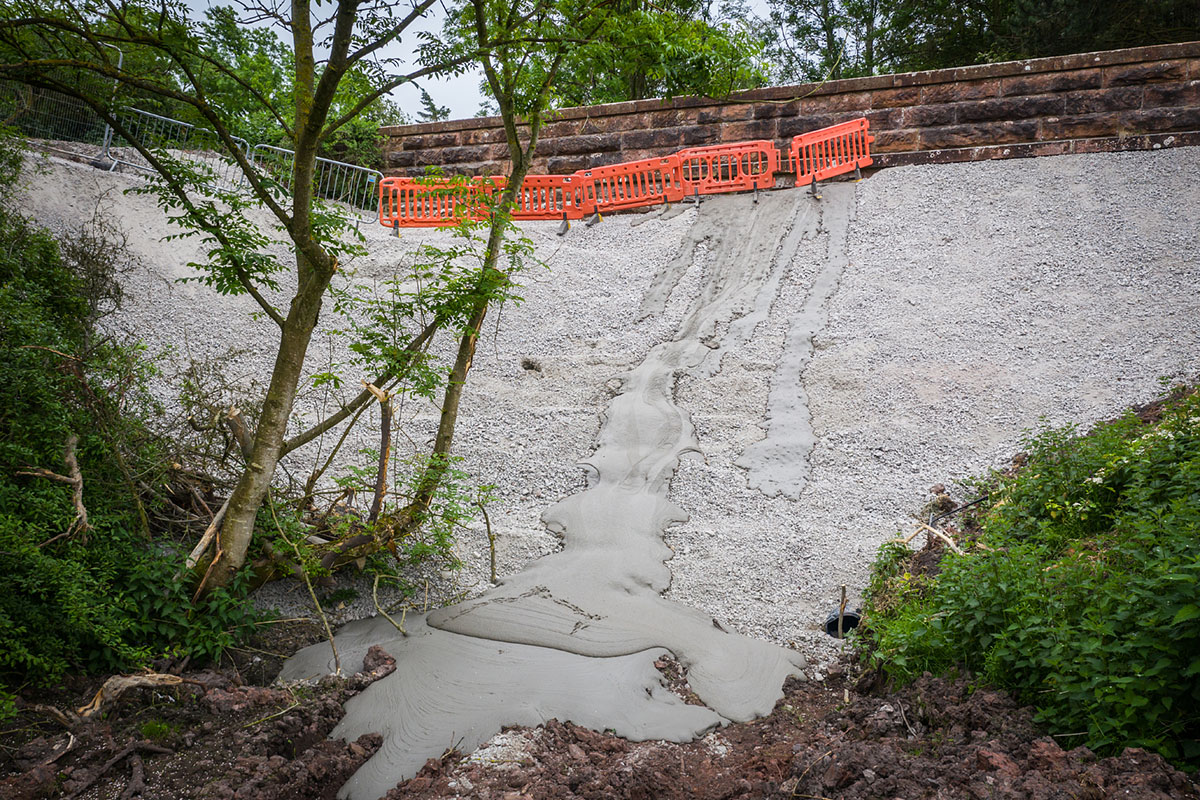the truth emerges

Testing the evidence
Several weeks of preparatory meetings and document gathering culminated in the holding of a public inquiry at the Duke’s Head in King’s Lynn from 21-24 May 2024, with a site visit and closing statements taking place on 6-7 June. National Highways put forward its engineer as an expert witness, as well as planning, heritage, ecology and landscape specialists from Jacobs. The Council’s contributors focussed on engineering, planning and heritage, the three topics upon which witnesses gave evidence and were cross-examined. The HRE Group offered broader insight through its role as a ‘Rule 6 Party’, based on three years of campaigning against NH’s socially damaging actions.

PHOTO: THE HRE GROUP
Predictably, National Highways sought to diminish the effects of infilling, suggesting that it “had not fundamentally harmed the non-designated heritage asset’s limited heritage value”. This was despite the bridge being a rare-surviving example of an early modular concrete structure, built to a system developed by a pioneer of reinforced concrete products.
With the exception of its parapets, it’s no longer possible to appreciate any part of the bridge’s form due to its almost complete burial in stone and concrete; the upper parts of the wing walls have been demolished. And yet NH claimed that infilling “maintains the bridge in its original function as a road bridge”, even though it no longer complies with the dictionary definition of a bridge - it doesn’t span anything; you can no longer pass under it.
The LPA rightly pointed out that the structure has been converted into an embankment. As the Request for Financial Authorisation stated, infilling has resulted in “a similar outcome” to demolition; thus, the harm inflicted must be substantial, though not necessarily permanent, even if intended to be. This level of harm warranted removal of the infill.
Back in 2019, Norfolk County Council told National Highways that the infilling of St Andrew’s Lane bridge would not affect plans to repurpose former railway corridors as part of an expansion of its active travel network, but the inquiry was told that the prospect of the dismantled King’s Lynn-Fakenham line being converted into a greenway was now under live consideration. The local Neighbourhood Plan “strongly supports” the proposal as, if delivered, the communities of Roydon, Pott Row and Congham could be seen as gateways into King’s Lynn, with residents using it to access workplaces and schools.
The HRE Group expressed its view that all ‘viable’ legacy railway bridges should be regarded as assets by default, noting that a 2022 report by Sustrans - which considered the active travel value of 75 bridges threatened with infilling or demolition - made clear that “an argument could be made for all the structures that, one day, they may be useful…”. The Group suggested that the infill should be removed from St Andrew’s Lane bridge to ensure that any future feasibility study was not prejudiced by the blocking of a possible route.
One local resident supported retention of the infill as the development had reduced the amount of flytipping around the structure. However Congham Parish Council wanted it removing, presenting a collection of objections around heritage, ecology, landscape, engineering and amenity.
.jpg) |
 |
PHOTOS: M&GN TRUST/THE HRE GROUP
Different times
The Planning Inspectorate notified the main parties of the Inspector’s decision on 10 July 2024. National Highways’ appeal was upheld, meaning that the bridge will remain infilled.
Laura Renaudon, the Inspector, described the case as “finely balanced” and indicated that the exploitation of Class Q rights was “rather misguided”, noting that “It is an unfortunate sequence of events that has resulted in this appeal seeking retrospective planning permission”. She explicitly stated that “The works were not carried out principally (if at all) for reasons of safety, although the improved carrying capacity of the bridge happens to be an outcome of the works.” This is a striking conclusion, undermining the public claims made by National Highways.
The Inspector acknowledged that “The harm to the value of the heritage asset is regrettable but needs to be balanced against the asset’s overall low significance, the fact that the bridge is preserved, albeit buried, and the other factors in the case.” She went on to conclude that “Accordingly I find that the development complies with the development plan for the area.”
It’s worth noting that National Highways has implemented new decision-making and stakeholder consultation processes since St Andrew’s Lane bridge was lost. The outcry arising from its unnecessary and destructive actions at Great Musgrave bridge in Cumbria caused the Government to intervene and pause NH’s major works programme in July 2021. Since then, the company has established a Stakeholder Advisory Forum to review proposals affecting any structure where infilling or demolition is an option. If either is selected, consent is required from the relevant Minister before planning permission is sought.

PHOTO: THE HRE GROUP
Positive steps have been taken in a better direction. There seems little prospect of Class Q being unlawfully applied again; neither is it likely that bridges with a notable history or any potential for repurposing will be proposed for infilling. Community engagement will also happen to ensure schemes don’t clash with local aspirations.
What appears not to have changed, however, is the willingness of National Highways to misrepresent its own formal engineering evidence and make claims that conflict with reality. Evidence from St Andrew’s Lane bridge, and elsewhere, demonstrates that infilling and demolition are simply asset management choices promoted primarily to reduce costs. That’s not inherently unreasonable so why are they unwilling to admit it? Perhaps because such a narrow view inflicted serious harm on structures with broader social value and ambitions for a more sustainable future. Responsible public bodies should be more enlightened and ensure their actions align with Government policy.
With a line now drawn under another of National Highways’ historical failures, perhaps we can refocus on delivering maximum benefit from the rest of the Historical Railways Estate. Enthusiastic engagement with those seeking to develop active travel routes under, over or through the structures will be a good start - and is happening in places - but this requires buy-in from the Department for Transport, not just our state-owned roads company. It’s not yet clear to what extent the DfT is prepared to accept a modest increase in liability.
The key issue here is mindset. If stakeholders see the HRE as a nationally valuable asset, surely its owner and custodian can.
 |
 |
About Us
The HRE Group is an alliance of walking, cycling and heritage campaigners, engineers and greenway developers who regard the Historical Railways Estate’s structures to be strategically valuable in the context of building a better future.
Last updated 21 October 2025
© 2025 The HRE Group


